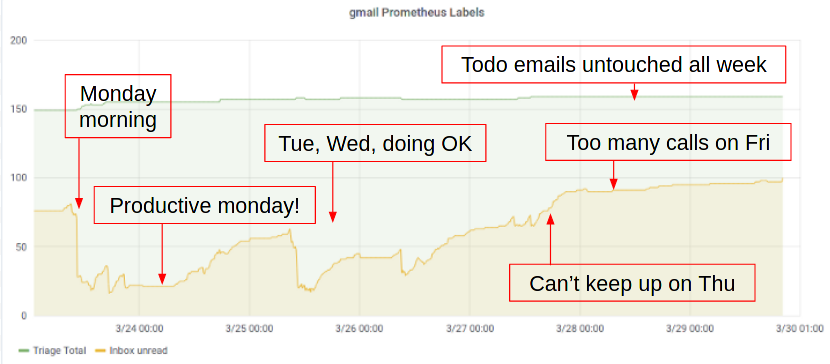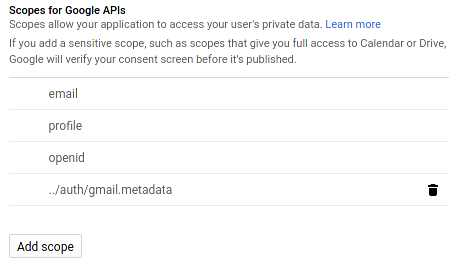Checks gmail labels for unread messages and exposes the counts via prometheus.
There is a blog article about why this was created, with an example integration to Grafana. It looks like this;
# HELP gmail_INBOX_total INBOX Total
# TYPE gmail_INBOX_total gauge
gmail_INBOX_total 44351.0
# HELP gmail_INBOX_unread INBOX Unread
# TYPE gmail_INBOX_unread gauge
gmail_INBOX_unread 43.0
# HELP gmail_Label_33_total >/0. Triage Total
# TYPE gmail_Label_33_total gauge
gmail_Label_33_total 159.0
# HELP gmail_Label_33_unread >/0. Triage Unread
# TYPE gmail_Label_33_unread gauge
gmail_Label_33_unread 0.0- Go to the Google Developers API Console: https://console.developers.google.com/apis/credentials
- Create Credentials -> OAuth Client ID
- Application Type: Desktop App (previously labeled Other) - NOT Web application
- Click the "down arrow" icon to download your credentials file -
client_secret___.json. - Create a OAuth 2 Consent screen with whatever name and icon you like. The scopes needed are;
- Rename your downloaded
client_secret_____.jsonto justclient_secret.jsonand put it in the directory;~/.prometheus-gmail-exporter/.
To use this on Google Accounts with Advanced Protection, you cannot use an OAuth consent screen that is only in Publishing status = Testing, but must Publish the App and then have it verified.
The ~/.prometheus-gmail-exporter/client_secret.json (above) which you download from Google (only) identifies (your own instance of) this tool.
The ~/.prometheus-gmail-exporter/login_cookie.dat secret identifies and gives access to your Gmail account via Google's API. This file cannot be directly downloaded from the Google Cloud Console, but is created by this tool on its first run, via an OAuth-based flow. It will open a local web browser to a Google Login. If this fails (e.g. due to an "Error 400: redirect_uri_mismatch"), then you can visit an URL to authorize this application, which is printed by the tool on its first run. Both will (should) redirect to http://localhost:9090/ (which has to be added as an Authorized redirect URI to the OAuth 2.0 Client ID) to complete the authentication flow, which then creates this file. (With that, the tool will then proceed further, and on the next run possibly print a message with a URL to click on to enable the Gmail API.)
To run this tool on a headless server, you may want to first create the login_cookie.dat on a Desktop/Workstation where a web browser is a available, and then move it to the headless server, perhaps by mounting this file from some form of secret provider into the container. (See also issue #9 for more background.)
There is a published container in hub.docker.com, called jamesread/prometheus-gmail-exporter:latest.
Using either docker or podman will be fine. I like podman better, so
examples are with podman.
podman run jamesread/prometheus-gmail-exporter:latest -v ~/.prometheus-gmail-exporter/:/root/.prometheus-gmail-exporter/
podman build . -t gmail-exporter
podman run -v ~/.prometheus-gmail-exporter/:/root/.prometheus-gmail-exporter/ gmail-exporter --labels Label_33
user@host: pip install -r requirements.txt
user@host: ./gmail-exporter.py --labels Label_33 INBOX
Options can be found with --help.
user@host: dnf install -y python3-configargparse python3-oauth2client python3-google-api-client python3-google-auth-oauthlib python3-prometheus_client
user@host: ./gmail-exporter.py --labels Label_33 INBOX
Options can be found with --help.

